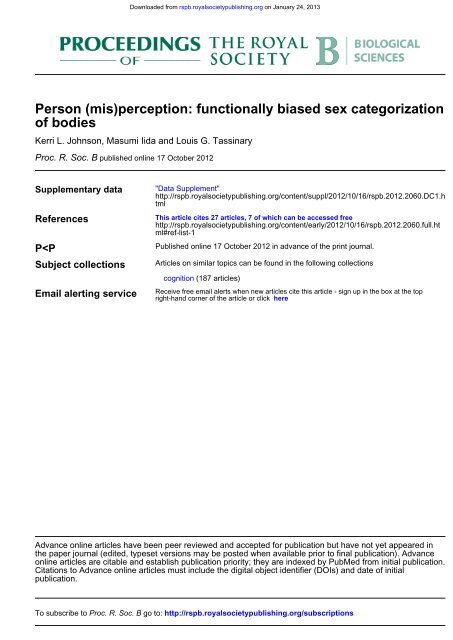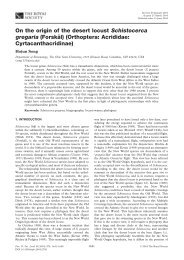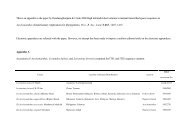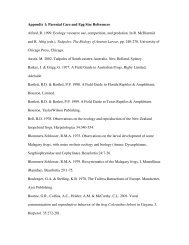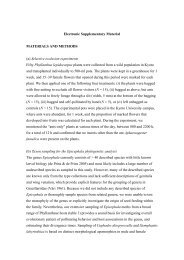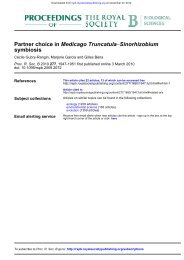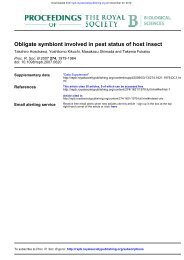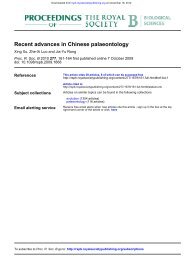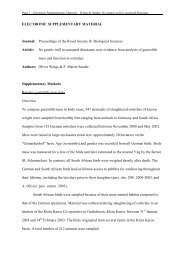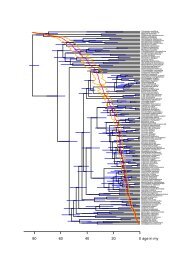Person (mis)perception: functionally biased sex categorization of ...
Person (mis)perception: functionally biased sex categorization of ...
Person (mis)perception: functionally biased sex categorization of ...
Create successful ePaper yourself
Turn your PDF publications into a flip-book with our unique Google optimized e-Paper software.
<strong>Person</strong> (<strong>mis</strong>)<strong>perception</strong>: <strong>functionally</strong> <strong>biased</strong> <strong>sex</strong> <strong>categorization</strong><br />
<strong>of</strong> bodies<br />
Kerri L. Johnson, Masumi Iida and Louis G. Tassinary<br />
Proc. R. Soc. B published online 17 October 2012<br />
Supplementary data<br />
References<br />
P
Downloaded from<br />
rspb.royalsocietypublishing.org on January 24, 2013<br />
<strong>Person</strong> (<strong>mis</strong>)<strong>perception</strong>: <strong>functionally</strong> <strong>biased</strong><br />
<strong>sex</strong> <strong>categorization</strong> <strong>of</strong> bodies<br />
Kerri L. Johnson 1, *, Masumi Iida 2 and Louis G. Tassinary 3<br />
1 Department <strong>of</strong> Communication Studies and Department <strong>of</strong> Psychology, University <strong>of</strong> California at Los Angeles,<br />
2330 Rolfe Hall, Los Angeles, CA 90403, USA<br />
2 School <strong>of</strong> Social and Family Dynamics, Arizona State University, 951 South Cady Mall, Tempe, AZ 85287, USA<br />
3 Department <strong>of</strong> Visualization, Texas A&M University, College Station, TX 77843, USA<br />
Social <strong>perception</strong> is among the most important tasks that occur in daily life, and perceivers readily<br />
appreciate the social affordances <strong>of</strong> others. Here, we demonstrate that <strong>sex</strong> <strong>categorization</strong>s are <strong>functionally</strong><br />
<strong>biased</strong> towards a male percept. Perceivers judged body shapes that varied in waist-to-hip ratio to be men if<br />
they were not, in reality, exclusive to women, and male <strong>categorization</strong>s occurred more quickly than female<br />
<strong>categorization</strong>s (studies 1 and 4). This pattern was corroborated when participants identified the average<br />
body shapes <strong>of</strong> men and women (study 2) and when we assessed participants’ cognitive representations<br />
(study 3). Moreover, these tendencies were modulated by emotion context (study 4). Thus, male <strong>categorization</strong>s<br />
occurred readily and rapidly, demonstrating a pronounced <strong>categorization</strong> bias and temporal<br />
advantage for male judgements.<br />
Keywords: person <strong>perception</strong>; <strong>sex</strong> <strong>categorization</strong>; <strong>sex</strong>ual dimorphism; waist-to-hip ratio;<br />
body <strong>perception</strong><br />
1. INTRODUCTION<br />
Social <strong>categorization</strong> is among the most important tasks<br />
facing perceivers. Abundant evidence suggests that <strong>categorization</strong>s<br />
<strong>of</strong> <strong>sex</strong>, race, age and even <strong>sex</strong>ual orientation<br />
occur in a largely obligatory fashion [1,2], and through<br />
the use <strong>of</strong> cues in the face and body [3,4]. Here, we propose<br />
that <strong>sex</strong> <strong>categorization</strong> which relies on body cues<br />
may be systematically <strong>biased</strong> towards a male percept.<br />
Although both face and body cues inform <strong>sex</strong> <strong>categorization</strong>s,<br />
there is reason to suspect that their use may<br />
not promote equivalent accuracy. Sex <strong>categorization</strong> that<br />
relies on facial cues, for example, necessarily occurs at a<br />
relatively close physical proximity. Evidence suggests<br />
that <strong>sex</strong>ually dimorphic cues inform <strong>sex</strong> <strong>categorization</strong>s<br />
in a dynamic fashion [3], and that such judgements are<br />
overwhelmingly accurate [5].<br />
The body communicates meaningful information to<br />
others, including social category membership [4], intentions<br />
[6], emotions [7,8] and even physical vulnerability<br />
[9]. These <strong>perception</strong>s can be accomplished from a substantial<br />
physical distance, in part, because <strong>of</strong> the body’s<br />
size. While perceiving others at a distance may produce<br />
some errors in social <strong>perception</strong>s, it also provides an<br />
important benefit—allowing a perceiver to avoid others<br />
who may pose threats to personal safety [10]. Social <strong>perception</strong>s<br />
therefore instantiate social affordances [11–13],<br />
and they are likely to vary, depending on another person’s<br />
physical formidability [14,15].<br />
The formidability <strong>of</strong> men and women is asymmetric.<br />
Compared with women, men are not only physically stronger<br />
[15], but also prone to aggression [14] and violent<br />
* Author for correspondence (kerri.johnson@ucla.edu).<br />
Electronic supplementary material is available at http://dx.doi.org/<br />
10.1098/rspb.2012.2060 or via http://rspb.royalsocietypublishing.org.<br />
Proc. R. Soc. B<br />
doi:10.1098/rspb.2012.2060<br />
Published online<br />
crime [16]. Consequently, unknown men pose a potential<br />
threat to perceivers. These differences may compel perceivers<br />
to avoid risky others (men), but embolden perceivers to<br />
approach benign others (women).<br />
We propose that these considerations will affect <strong>sex</strong> <strong>categorization</strong>s.<br />
Specifically, <strong>sex</strong> <strong>categorization</strong>s are likely to<br />
weigh risk factors and situational contexts in a manner<br />
that optimizes personal safety. In social <strong>perception</strong>, accuracy<br />
is undoubtedly desirable in some circumstances, but<br />
it may be costly in others. The physical proximity necessary<br />
to achieve accurate social <strong>perception</strong> may foreclose one’s<br />
option to avoid contact with physically formidable others.<br />
Therefore, social <strong>perception</strong>s from body cues are likely to<br />
be not only error-prone, but also systematically <strong>biased</strong>.<br />
Miscategorizing a woman to be a man may unnecessarily<br />
compel a perceiver to avoid contact, but it is an error committed<br />
in prudence. Miscategorizing a man to be a woman,<br />
by contrast, is an error that may expose a perceiver to<br />
physical risks.<br />
Thus, the costs associated with <strong>sex</strong>-<strong>categorization</strong><br />
errors are hypothesized to be asymmetric. Put directly, <strong>mis</strong>categorizing<br />
a woman to be a man is a low-cost error;<br />
<strong>mis</strong>categorizing a man to be a woman is an error that is<br />
potentially costly to one’s physical safety. Such asymmetric<br />
costs would therefore lead perceivers to adopt a ‘better safe<br />
than sorry’ heuristic that produces systematic errors that<br />
maximize utility, as observed in other judgements [17,18].<br />
Taken together, the tendency for <strong>sex</strong> categories to cue<br />
physical formidability and a proclivity towards perceptual<br />
biases that minimize potential costs to oneself led us to<br />
predict that <strong>sex</strong> <strong>categorization</strong> would be systematically<br />
<strong>biased</strong> towards a male percept. More specifically, we predicted<br />
that any body that is not, in reality, exclusive to<br />
women would evidence a significant male <strong>categorization</strong><br />
bias. We also predicted that male <strong>categorization</strong>s would<br />
be rendered more quickly than female <strong>categorization</strong>s<br />
Received 3 September 2012<br />
Accepted 27 September 2012 1 This journal is q 2012 The Royal Society
2 K. L. Johnson <strong>Person</strong> (<strong>mis</strong>)<strong>perception</strong><br />
ins<strong>of</strong>ar as a rapid <strong>categorization</strong> also enables a rapid<br />
retreat if warranted, thus also serving self-protective<br />
goals. Here, we describe four studies in which we explored<br />
the prevalence <strong>of</strong> biases in <strong>sex</strong> <strong>categorization</strong> (studies 1 and<br />
2), the cognitive representation <strong>of</strong> men’s and women’s<br />
bodies (study 3), and the contextual determinants <strong>of</strong><br />
<strong>sex</strong>-<strong>categorization</strong> biases (study 4).<br />
2. STUDY 1<br />
(a) Method<br />
(i) Participants<br />
Fifty-three undergraduates (36 women, 17 men) participated<br />
in exchange for course credit.<br />
(ii) Materials and procedure<br />
Stimuli included 21 computer-generated bodies [4,19,20]<br />
that varied in a <strong>sex</strong>ually dimorphic cue, the waist-to-hip<br />
ratio (WHR; figure 1).<br />
Bodies were presented in five blocks <strong>of</strong> trials on<br />
a Macintosh computer running customized s<strong>of</strong>tware.<br />
In a preview block, participants merely viewed each body<br />
to become familiar with the range <strong>of</strong> stimuli. In subsequent<br />
blocks, each trial consisted <strong>of</strong> a ‘ready?’ prompt (1000 ms)<br />
followed by a randomly selected body. Participants<br />
categorized <strong>sex</strong> via a button press.<br />
(iii) Comparison group<br />
For comparison, we obtained body measurements <strong>of</strong><br />
4803 army recruits (2261 men, 2542 women) from existing<br />
databases [21,22], a population that we have found to<br />
be anthropometrically comparable to our own research<br />
population. We computed each recruit’s WHR, using<br />
standard anthropometric markers.<br />
(b) Results and discussion<br />
(i) Analytic strategy<br />
We sought to: (i) specify the actual distribution <strong>of</strong> men<br />
and women who embody each WHR, (ii) describe the<br />
distribution <strong>of</strong> male/female <strong>categorization</strong>s for each<br />
WHR, and (iii) compare these two distributions.<br />
(ii) Actual <strong>sex</strong> distribution<br />
We first characterized the distribution <strong>of</strong> men and women<br />
for each WHR among the army recruits. As seen in<br />
figure 2, WHRs <strong>of</strong> 0.62 and below were non-existent;<br />
WHRs between 0.64 and 0.72 were exclusive to women.<br />
The first WHRs in which men were represented was at a<br />
WHR ¼ 0.74. Although men were rare in this category<br />
(0.6%), their presence demarcated a significant departure<br />
from exclusivity, x 2 1 ¼ 12.169, p , 0.001. This was true<br />
for every WHR thereafter, and the difference increased<br />
with WHR (see the electronic supplementary material for<br />
body stimuli varying in waist-to-hip ratio<br />
Figure 1 Stimuli used in studies 1, 2 and 4. Waist-to-hip ratio (WHR) increased in increments <strong>of</strong> two one-hundredths <strong>of</strong> a unit<br />
from an ‘hourglass’ WHR ¼ 0.50 to a more ‘tubular’ WHR ¼ 0.90.<br />
Proc. R. Soc. B<br />
Downloaded from<br />
rspb.royalsocietypublishing.org on January 24, 2013<br />
full x 2 statistics). Thus, beginning with a WHR <strong>of</strong> 0.74,<br />
body shapes are not exclusive to women.<br />
We used two methods to identify the WHR that demarcates<br />
the boundary at which bodies shift from being<br />
predominantly women to being predominantly men<br />
(i.e. the actual boundary). We coded each recruit’s <strong>sex</strong><br />
(0 ¼ male, 1 ¼ female), and we compared the distribution<br />
with chance (i.e. expected value ¼ 0.50). As notated in<br />
figure 2, WHRs between 0.64 and 0.78 were common for<br />
women, x 2 1s from 118.642 to 498.071, all ps , 0.0001;<br />
WHRs between 0.82 and 1.09 were common for<br />
men, x 2 1s from 103.039 to 301.884, all ps , 0.0001; a<br />
WHR ¼ 0.80 was androgynous, x 2 1 ¼ 0.162, p ¼ 0.688<br />
(see the electronic supplementary material for full x 2<br />
statistics). These findings demonstrate a dramatic and<br />
rapid shift in <strong>sex</strong> distribution for a WHR <strong>of</strong> 0.80.<br />
Second, we estimated the relationship between body<br />
shape and <strong>sex</strong> distribution by regressing recruit <strong>sex</strong> onto<br />
WHR. The effect <strong>of</strong> WHR was strong, B ¼ 25.674,<br />
s.e. ¼ 0.067, t ¼ 284.461, p , 0.0001. We identified<br />
the specific WHR that demarcated the boundary at<br />
which the <strong>sex</strong> ratio shifted from being predominantly<br />
women to being predominantly men by solving for the<br />
equation, 2B 0/B 1 [23]. This calculation also identified<br />
the actual boundary between men’s and women’s bodies<br />
to be a WHR ¼ 0.8049.<br />
(iii) Perceived <strong>sex</strong> distribution<br />
Next, we tested our prediction that systematic biases in <strong>sex</strong><br />
<strong>categorization</strong>s would be evident beginning with body<br />
shapes that were not exclusive to women. We computed<br />
an index that represented each participant’s proportion <strong>of</strong><br />
‘female’ judgements (range ¼ 0–1) for each WHR.<br />
We characterized the distribution <strong>of</strong> <strong>sex</strong> <strong>categorization</strong>s<br />
across the WHRs in two ways. First, we computed each participant’s<br />
proportion <strong>of</strong> ‘female’ <strong>categorization</strong>s for each<br />
body shape, and we compared this against an expected<br />
value <strong>of</strong> 50 per cent, using one-sample t-tests with<br />
Bonferroni corrections. As notated within figure 2 and<br />
elaborated in the electronic supplementary material,<br />
bodies with WHRs between 0.50 and 0.66 were reliably<br />
judged to be female; bodies with WHRs between 0.70<br />
and 0.90 were reliably judged to be male. Judgements <strong>of</strong><br />
bodies with WHR ¼ 0.68 did not differ from chance, indicating<br />
the boundary at which <strong>perception</strong>s shifted from<br />
being predominantly male to being predominantly female.<br />
Second, we tested the shape <strong>of</strong> the distribution using<br />
generalized estimating equations (GEEs) [24] to account<br />
for repeated judgements within participant and to accommodate<br />
a dichotomous dependent variable. Not surprisingly<br />
given the response distribution, we found a significant effects<br />
for linear and quadratic functions, Bs ¼ 230.915 and<br />
18.599, s.e.s ¼ 1.883 and 8.549, zs ¼ 216.420 and 2.180,
per cent ‘female’<br />
(scatter plot)<br />
100<br />
80<br />
60<br />
40<br />
20<br />
0<br />
chance: * * * * * * * * * n.s. * * * * * * * * * * *<br />
reality:<br />
* * * * * * * * * * * n.s. * n.s.<br />
0.50<br />
0.54<br />
0.58<br />
0.62<br />
0.66<br />
0.70<br />
and ps , 0.0001 and ¼ 0.029, and a marginally significant<br />
effect for the cubic function, B ¼ 161.322,<br />
s.e. ¼ 87.501, z ¼ 1.840 and p ¼ 0.65.<br />
We also quantified the exact perceptual boundary<br />
for each participant by running logistic multilevel analyses<br />
in HLM v. 7.0 [25]. We used each participant’s<br />
estimated intercept and slope coefficients (calculated<br />
using an empirical Bayes approach) [26, pp. 90–102] to<br />
calculate each participant’s perceptual boundary between<br />
male and female bodies. This measure confirmed the<br />
WHR at which each participant’s perceptual boundary<br />
between female and male body shapes (M ¼ 0.685,<br />
s.e. ¼ 0.004, range ¼ 0.576–0.746; see notation in<br />
figure 2). This estimate did not differ by participant <strong>sex</strong>,<br />
t 51 ¼ 1.061, p ¼ 0.294.<br />
(iv) Comparing the distributions<br />
Next, we tested our prediction that <strong>sex</strong> <strong>categorization</strong>s<br />
would be <strong>biased</strong>. We compared the perceived <strong>sex</strong> distribution<br />
with the actual <strong>sex</strong> distribution in army recruits<br />
within each WHR category, using one-sample t-tests<br />
with Bonferroni corrections (see notation in figure 2<br />
and electronic supplementary material). No recruit<br />
embodied WHRs between 0.50 and 0.62. Nevertheless,<br />
our participants readily categorized these bodies to be<br />
women. WHRs that fell between 0.64 and 0.72 were<br />
exclusive to women in the army database, yet participants’<br />
<strong>categorization</strong>s did not reflect this. Instead,<br />
participants judged a sizable portion <strong>of</strong> targets within<br />
each <strong>of</strong> these WHR categories to be men, with a preponderance<br />
<strong>of</strong> ‘male’ judgements by a WHR ¼ 0.70. This<br />
0.74<br />
0.78<br />
0.82<br />
reality<br />
<strong>perception</strong><br />
perceived boundary<br />
actual boundary<br />
Figure 2 Perceived and actual <strong>sex</strong> distributions from study 1. Scatter plot curves depict the percentage <strong>of</strong> women within each<br />
WHR category in reality (circles) and <strong>perception</strong> (squares). The histogram depicts the number <strong>of</strong> participants whose perceived<br />
boundary fell at each WHR. Sex distributions that differ from an expected value <strong>of</strong> 50% and for which the perceived<br />
distribution differs from the actual distribution are noted below the figure by an asterisk.<br />
Proc. R. Soc. B<br />
Downloaded from<br />
rspb.royalsocietypublishing.org on January 24, 2013<br />
0.86<br />
0.90<br />
<strong>Person</strong> (<strong>mis</strong>)<strong>perception</strong> K. L. Johnson 3<br />
0.94<br />
0.98<br />
perceived boundary—count<br />
(histogram)<br />
disparity between <strong>perception</strong> and reality continued up<br />
to a WHR <strong>of</strong> 0.88.<br />
We also compared the perceived boundary (calculated<br />
for each observer as described above) against the actual<br />
anthropometric boundary (WHR ¼ 0.8049) using a<br />
one-sample t-test. The perceived boundary (M ¼ 0.68,<br />
s.e. ¼ 0.004) was substantially smaller, t 52 ¼ 229.799,<br />
p , 0.001.<br />
These findings are consistent with our prediction that<br />
<strong>sex</strong> <strong>categorization</strong>s reflect a male bias for all body shapes<br />
that are not exclusive to women. Indeed, a WHR <strong>of</strong><br />
0.74—the body shape where we observed the first departure<br />
from being exclusive to women—compelled 85 per<br />
cent ‘male’ judgements. Additionally, we also observed a<br />
significant bias for two smaller WHRs that are, in reality,<br />
exclusive to women (i.e. WHRs ¼ 0.70 and 0.72).<br />
(v) Response latency<br />
Finally, we tested our prediction that ‘male’ <strong>categorization</strong>s<br />
would be rendered more quickly than ‘female’<br />
<strong>categorization</strong>s. Using GEE, we regressed response<br />
latency onto WHR (centred at WHR ¼ 0.70), <strong>sex</strong> category<br />
judgement (effect coded, male ¼ 20.5, female ¼<br />
0.5) and their interaction. When centred at a<br />
WHR ¼ 0.70, response latencies were 459 ms longer<br />
for ‘female’ judgements than ‘male’ judgements, B ¼<br />
459.949, s.e. ¼ 137.952, z ¼ 3.330, p ¼ 0.0009, and<br />
increased with WHR, B ¼ 1694.740, s.e. ¼ 473.708,<br />
z ¼ 3.580, p ¼ 0.0003. Most importantly, the interaction<br />
between the two was significant, B ¼ 8973.584,<br />
s.e. ¼ 1420.842, z ¼ 6.32, p , 0.0001.<br />
20<br />
16<br />
12<br />
8<br />
4<br />
0
4 K. L. Johnson <strong>Person</strong> (<strong>mis</strong>)<strong>perception</strong><br />
According to our hypothesis, a temporal advantage for<br />
male <strong>categorization</strong>s should occur for any WHR where<br />
variability exists. Therefore, we followed the significant<br />
interaction by testing the simple slope <strong>of</strong> <strong>sex</strong> at<br />
four other relevant benchmarks: the WHR demarcating<br />
the perceived <strong>sex</strong> boundary (i.e. WHR ¼ 0.6850), the<br />
WHR demarcating the actual <strong>sex</strong> boundary (i.e.<br />
WHR ¼ 0.8049) and the WHR demarcating the most<br />
extreme ‘female’ and ‘male’ WHRs (i.e. WHRs ¼ 0.50<br />
and 0.90, respectively). Testing these benchmarks, in particular,<br />
provided compelling tests for the specificity and<br />
generality <strong>of</strong> the male <strong>categorization</strong> temporal advantage.<br />
A significant temporal advantage for male <strong>categorization</strong>s<br />
began with the perceived boundary (280 ms advantage),<br />
and continued through the actual boundary (1357 ms<br />
advantage) and extreme ‘male’ WHR (2254 ms<br />
advantage), Bs ¼ 280.478, 1357.308 and 2254.666,<br />
s.e.s ¼ 115.772, 267.196 and 405.133, zs ¼ 2.420,<br />
5.080 and 5.570, ps ¼ 0.015, and ,0.0001, respectively.<br />
Below the perceived boundary, in contrast, we found no<br />
temporal advantage for male <strong>categorization</strong>s.<br />
Thus, two important patterns emerged in these data.<br />
First, the perceived boundary between men’s and<br />
women’s bodies was a body shape that was exclusive to<br />
women. Second, bodies for which a male <strong>categorization</strong><br />
is tenable (even if unlikely) showed a remarkable male<br />
<strong>categorization</strong> bias. It is important to note that the only<br />
bodies which evidenced a significant female <strong>categorization</strong><br />
bias were those body shapes that do not exist in<br />
nature. Moreover, beginning at the perceived boundary,<br />
male <strong>categorization</strong>s were rendered more quickly than<br />
female <strong>categorization</strong>s. Thus, as predicted, male <strong>categorization</strong>s<br />
were both conservative and quick.<br />
(vi) Replication analysis<br />
These findings provide evidence that perceivers exhibit a<br />
male <strong>categorization</strong> bias, yet they do not eliminate the possibility<br />
that perceivers relied on the range <strong>of</strong> stimuli to render<br />
judgements. If participants used this strategy, they may have<br />
sur<strong>mis</strong>ed that the boundary lay at the midpoint <strong>of</strong> the scale<br />
<strong>of</strong> WHRs. We aimed to overcome this concern in several<br />
ways. Here, we replicated our key finding using a more<br />
narrow range <strong>of</strong> stimuli. Specifically, 102 participants categorized<br />
bodies with body shapes that were within observed<br />
human variation (i.e. WHRs between 0.64 and 0.90). Once<br />
again, the perceived boundary (M ¼ 0.75, s.e. ¼ 0.003)<br />
was significantly below the actual boundary, one-sample<br />
t101 ¼ 215.236, p , 0.0001, thus corroborating our initial<br />
observations. We next aimed to provide additional support<br />
for our claims using an identification task (study 2) and a<br />
reverse-correlation technique (study 3).<br />
3. STUDY 2<br />
(a) Method<br />
(i) Participants<br />
Thirty-one students (six women, 25 men) participated in<br />
this study for course credit.<br />
(ii) Materials and procedure<br />
Stimuli included the 21 bodies from study 1. Bodies were<br />
presented simultaneously to participants in a questionnaire<br />
(e.g. as the stimuli appear in figure 1). Within the ‘line-up,’<br />
participants identified the average male body, the average<br />
Proc. R. Soc. B<br />
Downloaded from<br />
rspb.royalsocietypublishing.org on January 24, 2013<br />
female body, and the boundary between the two. The average<br />
male and female bodies were described to be ‘the body<br />
that best represents the body shape <strong>of</strong> the men (women)<br />
you encounter each day.’ The boundary was described as,<br />
‘the point in the line up where, in reality, the distribution<br />
<strong>of</strong> men/women changes from being mostly female to<br />
being mostly male.’ Participants were warned that the<br />
line-up depicted bodies that do not really exist in nature,<br />
and that their responses should reflect the bodies <strong>of</strong> men<br />
and women they see day to day.<br />
(b) Results and discussion<br />
We initially included participant <strong>sex</strong> as a factor in all<br />
analyses. No effect involving participant <strong>sex</strong> reached<br />
significance and as such, it was dropped from all analyses.<br />
We analysed the WHRs selected for each judgement<br />
(i.e. the average male body, the average female body,<br />
and the boundary between), using a repeated-measures<br />
ANOVA. These judgements differed from one another,<br />
F 2,58 ¼ 240.900, p , 0.001. The WHR selected to represent<br />
the average female (M ¼ 0.568) was significantly<br />
smaller than the WHR selected to represent the average<br />
male (M ¼ 0.819), t 30 ¼ 218.690, p , 0.001. Both <strong>of</strong><br />
the perceived averages differed from the perceived boundary<br />
shift (M ¼ 0.713), t 30s ¼ 214.470 and 10.540, for<br />
the average male and female, respectively, both ps , 0.001.<br />
Importantly, these selections also differed from the<br />
anthropometric norms observed in study 1. We compared<br />
the selected WHRs with the anthropometric mean WHRs<br />
for men (M ¼ 0.892), woman (M ¼ 0.716), and the<br />
boundary between the two (M ¼ 0.8049). Each judgement<br />
differed significantly from the corresponding estimate in the<br />
army database, t 30s ¼ 220.86 (female), 24.980 (male) and<br />
–12.690 (boundary), all ps , 0.01. Thus, we again found<br />
evidence that perceivers exhibit a male <strong>categorization</strong> bias.<br />
4. STUDY 3<br />
In study 3, we used a reverse-correlation image classification<br />
paradigm [27,28] to identify the cognitive<br />
representation for men’s and women’s bodies. In this<br />
technique, random noise patterns were superimposed<br />
over a single base image. Across hundreds <strong>of</strong> two alternative<br />
forced choice trials, participants identified which <strong>of</strong><br />
two images resembled a specified category. When the<br />
noise patterns that a participant identified are collapsed<br />
across trials, the resulting images are theorized to depict<br />
a visual representation <strong>of</strong> the parameters that perceivers’<br />
used in their judgements. In study 3, we examined participants’<br />
representations for <strong>sex</strong>ually dimorphic body<br />
shapes. This technique has been used to identify the representations<br />
<strong>of</strong> individuals, emotion/social categories and<br />
aesthetic preferences [27]. Importantly, this technique is<br />
distribution free ins<strong>of</strong>ar as the base image remains constant<br />
across stimuli (here the anthropometric boundary<br />
WHR ¼ 0.8049), a characteristic that is ideal for testing<br />
biases in <strong>sex</strong> <strong>categorization</strong>.<br />
(a) Method<br />
(i) Participants<br />
Twenty-four students (13 women, nine men, two<br />
unreported) participated in this study for $10.
(ii) Materials and procedure<br />
Participants completed a reverse-correlation image <strong>categorization</strong><br />
task. Stimulus pairs were created using a base<br />
image <strong>of</strong> a body facing backward (WHR ¼ 0.8049; the<br />
anthropometric boundary). Using scripts from prior<br />
research [28], 60 noise patterns were created; these were<br />
added to and subtracted from the base image to create 60<br />
unique two alternative forced choice pairings. Across 700<br />
trials, these presumed male/female pairs were presented<br />
in random order to participants on a Macintosh computer<br />
running customized s<strong>of</strong>tware. Participants identified<br />
which image (left or right) depicted the woman with the<br />
presumption that the unselected image depicted the man.<br />
We averaged across all noise patterns that were identified<br />
as women/not-women to reconstructed each participant’s<br />
classification image for women and men. We then computed<br />
the WHR for each classification image from<br />
measurements <strong>of</strong> the width <strong>of</strong> the waist and hips in pixels,<br />
using the standard anthropometric landmarks in study 1.<br />
Finally, we reconstructed aggregate classification images<br />
by collapsing across all participants’ judgements.<br />
(b) Results and discussion<br />
Participants’ classification image for the female body<br />
had a WHR (M ¼ 0.681, s.e. ¼ 0.008) that was significantly<br />
smaller than both the anthropometric boundary<br />
and the anthropometric average woman, one-sample<br />
t 23s ¼ 214.675 and 24.137, ps , 0.0001 (figure 3a). Participants’<br />
classification image for the non-selected (i.e.<br />
male) body had a WHR (M ¼ 0.875, s.e. ¼ 0.009) that<br />
was significantly larger than the anthropometric boundary<br />
but marginally smaller than the anthropometric male<br />
body, one-sample t 23s ¼ 7.651 and 21.926, ps , 0.0001<br />
and ¼ 0.067 (figure 3b). Thus, using a method that is not<br />
vulnerable to scaling effects, we again found evidence for<br />
a significant male bias in <strong>sex</strong> category representations.<br />
Across four studies using three distinct methods, we<br />
have found consistent evidence for a systematic male<br />
<strong>categorization</strong> bias. Bodies that are more common <strong>of</strong><br />
women are nevertheless categorized as men a significant<br />
portion <strong>of</strong> the time; the representation <strong>of</strong> the average<br />
female—measured by both identification and in reverse<br />
correlations—is anthropometrically extreme. We contend<br />
that these biases reflect perceivers’ goal to minimize<br />
potential costs in social interactions [18].<br />
5. STUDY 4<br />
Having established this bias, we next sought to understand its<br />
functional underpinnings. The male <strong>categorization</strong> bias is<br />
likely to vary across contexts. Contexts that signal danger<br />
tends to alter cognitions [29], and they compel perceivers<br />
to parse their social world into stark ‘us’ and ‘them’ categories<br />
[10]. We predicted such circumstances may also compel<br />
more extreme biases, both in the absolute degree <strong>of</strong> bias<br />
and in the speed with which judgements are rendered. Contexts<br />
that signal safety, in contrast (e.g. a benign interaction in<br />
one’s <strong>of</strong>fice), may relax <strong>categorization</strong> biases. In study 4, we<br />
tested these predictions experimentally.<br />
(a) Method<br />
(i) Participants<br />
Two hundred and thirty-seven undergraduate students<br />
(196 women, 38 men, three unreported) participated in<br />
exchange for course credit.<br />
Proc. R. Soc. B<br />
Downloaded from<br />
rspb.royalsocietypublishing.org on January 24, 2013<br />
<strong>Person</strong> (<strong>mis</strong>)<strong>perception</strong> K. L. Johnson 5<br />
(a) (b)<br />
Figure 3 Reverse correlation classification images from<br />
study 3. (a) Images depict the average classification<br />
images the body identified to depict the woman and (b) the<br />
unselected body, by default, the male body.<br />
(ii) Materials and procedure<br />
Participants judged the <strong>sex</strong> category <strong>of</strong> stimuli from study 1<br />
in two blocks—one prior to and one after viewing a movie<br />
clip. Between the two, participants were randomly assigned<br />
to view one <strong>of</strong> four movie clips that reliably induce different<br />
states [30] including: (i) Fear—a woman is chased through<br />
a darkened house by a murderer; (ii) Positive—a dog<br />
comically attacks a man; (iii) Sadness—a young boy<br />
learns <strong>of</strong> his father’s death; and (iv) Control—a screen<br />
saver <strong>of</strong> fractal images.<br />
(b) Results and discussion<br />
(i) Boundary differences<br />
As in study 1, we estimated the perceived boundary for each<br />
participant, separately for pre- and post-manipulation <strong>categorization</strong>s.<br />
We analysed these boundaries using a<br />
two (participant <strong>sex</strong>) by four (condition) ANCOVA. The<br />
pre-manipulation boundary was related to the postmanipulation<br />
boundary, F1,225 ¼ 14.141, p ¼ 0.001, and<br />
it was therefore included as a covariate. Post-manipulation<br />
boundaries varied by condition, F 3,225 ¼ 2.920, p ¼ 0.035.<br />
Using planned contrasts, we compared the postmanipulation<br />
boundary in the Fear condition with<br />
other conditions. Boundaries in the Fear condition<br />
(M ¼ 0.687, s.e. ¼ 0.026) were significantly lower than<br />
in the Sad or Positive conditions (Ms ¼ 0.702 and<br />
0.692, s.e.s ¼ 0.024 and 0.041), t 115s, ¼2.429 and 2.286,<br />
ps ¼ 0.019 and 0.024, respectively; it did not differ,<br />
however, from the Control condition (M ¼ 0.692,<br />
s.e. ¼ 0.022), t 116 ¼ 0.429, n.s.<br />
These data provide some evidence that <strong>sex</strong>-<strong>categorization</strong><br />
biases are sensitive to context. Participants in the Fear and<br />
Control condition exhibited the strongest <strong>sex</strong>-<strong>categorization</strong><br />
biases. This suggests that although <strong>sex</strong>-<strong>categorization</strong> biases<br />
may be normative, they can be relaxed in some contexts (e.g.<br />
when in positive or sad states). The relatively small size<br />
<strong>of</strong> these differences is unsurprising for two reasons. First,<br />
these differences moderate an already robust bias. Second,<br />
this manipulation, although reliable, is non-consequential<br />
for perceivers. More pronounced biases are likely to manifest<br />
in real-life contexts (e.g. the fear that accompanies being<br />
followed by a stranger at night).<br />
(ii) Temporal advantages<br />
In study 1, we found a temporal advantage for male<br />
<strong>categorization</strong>s. We tested whether this advantage varied<br />
as a function <strong>of</strong> condition and WHR, specifically for<br />
post-manipulation judgements. We excluded trials for<br />
which response latency was more than 3 s.d.s greater
6 K. L. Johnson <strong>Person</strong> (<strong>mis</strong>)<strong>perception</strong><br />
Table 1 Response latencies (ms) as a function <strong>of</strong> condition<br />
in study 3.<br />
emotion condition<br />
Fear Control Sad Positive<br />
actual boundary<br />
male 884.66 927.02 990.55 920.79<br />
female 1544.41 1442.53 1559.29 1457.53<br />
temporal<br />
advantage<br />
perceived boundary<br />
659.75 515.51 568.74 536.74<br />
male 1064.34 1089.34 1243.78 1021.38<br />
female 1173.44 1152.94 1198.65 1135.89<br />
temporal<br />
advantage<br />
109.09 63.60 245.13 114.51<br />
than the mean because some latencies were exceedingly<br />
long (maximum ¼ 51 550 ms). Using GEE, we regressed<br />
response latency onto judgement (effect coded,<br />
male ¼ 20.5, female ¼ 0.5), WHR (centred at its midpoint)<br />
and condition (dummy coded). Importantly, the<br />
three-way interaction was significant, F 3,9583¼ 9.500,<br />
p , 0.0001, suggesting that <strong>sex</strong>-specific temporal advantages<br />
varied across condition and WHR. To test the<br />
nature <strong>of</strong> this interaction, we contrasted the simple<br />
slope <strong>of</strong> <strong>sex</strong> in the Fear condition against the corresponding<br />
simple slopes in the other conditions, separately for<br />
two benchmark WHRs (table 1).<br />
At the perceived boundary between men and<br />
women (i.e. WHR ¼ 0.68), male <strong>categorization</strong>s were<br />
significantly faster than female <strong>categorization</strong>s in the<br />
Fear condition, B ¼ 109.090, s.e. ¼ 35.509, z ¼ 5.500,<br />
p , 0.0001. Similar differences were obtained in the Control<br />
and Positive conditions, Bs ¼ 245.489 and 5.417,<br />
s.e.s ¼ 49.394 and 49.422, zs ¼ 20.920 and 0.110,<br />
respectively, n.s. The opposite pattern was obtained<br />
in the Sad condition, B ¼ 2154.230, s.e. ¼ 48.871,<br />
z ¼ 23.160, p ¼ 0.002. Thus, at a perceptually androgynous<br />
WHR, we observed a significant temporal advantage<br />
for male <strong>categorization</strong>s among three <strong>of</strong> the four conditions.<br />
At the actual boundary (i.e. WHR ¼ 0.80), male <strong>categorization</strong>s<br />
were again significantly faster than female<br />
<strong>categorization</strong>s in the Fear condition, B ¼ 659.750,<br />
s.e. ¼ 47.569, z ¼ 13.870, and p , 0.0001. At this<br />
benchmark, this difference was most pronounced in the<br />
Fear condition. The temporal advantage was attenuated<br />
somewhat in the Sad condition, B ¼ 291.019,<br />
s.e. ¼ 64.084, z ¼ 21.420, p ¼ 0.156; and it was<br />
significantly reduced in the Control and Positive conditions,<br />
Bs ¼ 2144.240 and 2123.010, s.e.s ¼ 66.799<br />
and 65.951, zs ¼ 22.160 and 21.870, ps ¼ 0.031 and<br />
0.062, respectively. Thus, for bodies that arouse confident<br />
male percepts—in spite <strong>of</strong> their actual androgyny—<br />
the male <strong>categorization</strong> temporal advantage was most<br />
pronounced in the Fear condition.<br />
Collectively, these findings highlight a pattern <strong>of</strong> systematic<br />
biases that are consistent with contextual<br />
modulation. The tendency for <strong>sex</strong> <strong>categorization</strong> to be<br />
<strong>biased</strong> was common to all conditions, but was most pronounced<br />
in the Control and Fear conditions. These<br />
tendencies were slightly relaxed in the Sad and Happy<br />
conditions. This suggests that although a male<br />
Proc. R. Soc. B<br />
Downloaded from<br />
rspb.royalsocietypublishing.org on January 24, 2013<br />
<strong>categorization</strong> bias may be pronounced, in general, it<br />
may be attenuated somewhat when one’s context promotes<br />
a relaxation <strong>of</strong> vigilance. Additionally, analyses <strong>of</strong><br />
response latencies provided additional support. Overall,<br />
male <strong>categorization</strong>s occurred more quickly than female<br />
<strong>categorization</strong>s. This tendency was strongest in the Fear<br />
condition, especially when categorizing bodies that are<br />
overwhelmingly judged to be men.<br />
6. GENERAL DISCUSSION<br />
Across four unique studies and one replication that used<br />
diverse methods, we documented a consistent pattern<br />
in which perceivers were <strong>biased</strong> to judge others to be men.<br />
In all studies, we found that perceivers categorized bodies<br />
to be men, even when the WHRs were actually more<br />
common to women. This was true in diverse tasks including<br />
<strong>categorization</strong> (studies 1 and 4), identification (study 2),<br />
and reverse-correlation (study 3). Moreover, male <strong>categorization</strong>s<br />
were rendered more rapidly than female<br />
<strong>categorization</strong>s (studies 1 and 4). Finally, we demonstrated<br />
that these biases are contextually sensitive (study 4).<br />
Collectively, these findings support our hypothesis that<br />
<strong>sex</strong> <strong>categorization</strong>s are <strong>functionally</strong> <strong>biased</strong> towards a male<br />
percept. Although this bias produces <strong>sex</strong>-<strong>categorization</strong><br />
errors, they should not be construed as <strong>mis</strong>takes. Indeed,<br />
unknown men and women are not equally formidable.<br />
The tendency to err on the side <strong>of</strong> caution highlights<br />
a remarkable sensitivity to the social affordances <strong>of</strong><br />
others. Consequently, <strong>sex</strong>-<strong>categorization</strong> biases are functional,<br />
even though they are error-prone [17,18].<br />
(a) Specificity considerations<br />
We have argued that the male <strong>categorization</strong> biases<br />
stemmed from a functional bias. Two additional factors<br />
warrant consideration. First, others have argued persuasively<br />
that certain social categories serve as ‘default’<br />
social judgements [31–33]. Although this perspective is<br />
consistent with the pattern <strong>of</strong> results that we have<br />
described, it does not provide an alternate theoretical<br />
account. To our reckoning, our analysis <strong>of</strong> this tendency<br />
pinpoints the functional underpinnings that lead ‘male’<br />
to be the default social judgement.<br />
Second, our reliance on computer-generated stimuli<br />
opens the possibility that <strong>sex</strong>-<strong>categorization</strong> biases may be<br />
observed only for judgements <strong>of</strong> tightly controlled stimuli,<br />
but not for other complex stimuli. To gain some insight into<br />
the generality <strong>of</strong> the effect, we reanalysed data from other<br />
research [34] <strong>of</strong> which a subset is relevant here. Participants<br />
categorized the <strong>sex</strong> <strong>of</strong> point-light-defined walking motions<br />
<strong>of</strong> actual men and women. We analysed <strong>sex</strong>-<strong>categorization</strong><br />
biases for two walking speeds—one self-paced, and one<br />
accelerated pace. We reasoned that to the extent that a<br />
<strong>sex</strong>-<strong>categorization</strong> bias exists, it may be modulated by the<br />
speed <strong>of</strong> a person’s approach such that biases would be<br />
more pronounced for judgements <strong>of</strong> individuals who are<br />
approaching rapidly. As predicted, male <strong>categorization</strong>s<br />
were 11 per cent more likely than female <strong>categorization</strong>s,<br />
B ¼ 20.114, s.e. ¼ 0.048, z ¼ 22.370, p ¼ 0.018, odds<br />
ratio (OR) ¼ 0.892. This tendency was exacerbated<br />
for accelerated walks, B ¼ 20.139, s.e. ¼ 0.054,<br />
z ¼ 22.600, p ¼ 0.009, OR ¼ 0.869. Moreover, similar<br />
biases have been observed for judgements <strong>of</strong> other pointlight-defined<br />
motions: male <strong>categorization</strong> biases are
more pronounced when the target moves in an angry<br />
fashion [35] or when a target is approaching the viewer<br />
[36]. Thus, the male <strong>categorization</strong> bias appears to generalize<br />
to other <strong>perception</strong>s, including body motions, and it<br />
appears to be modulated by factors such as emotion state,<br />
facing direction and speed <strong>of</strong> approach that could heighten<br />
a perceiver’s vigilance.<br />
(b) Durability considerations<br />
Male <strong>categorization</strong> biases may persist in spite <strong>of</strong> occasional<br />
disconfirmation <strong>of</strong> initial impressions. It is important to<br />
note that this bias is presumed to be functional precisely<br />
because it enables perceivers to alter their behaviours to<br />
avoid physically formidable others. In such cases, <strong>categorization</strong><br />
errors will escape disconfirmation entirely. Therefore,<br />
these functional ends will justify the <strong>biased</strong> cognitive<br />
representations, enabling <strong>categorization</strong> biases to persist.<br />
At times, however, the benefits <strong>of</strong> bias will be outweighed<br />
by the importance <strong>of</strong> accuracy. Upon<br />
interaction, it is unlikely that a <strong>categorization</strong> error will<br />
persist, even if it occurred initially. Instead, when in<br />
close proximity <strong>of</strong> another person, <strong>sex</strong>ually dimorphic<br />
cues are likely to be highly salient. Therefore, whereas<br />
early in <strong>perception</strong>, the mere possibility that a target<br />
may be a man may be sufficient to compel a male <strong>categorization</strong>,<br />
the accumulation <strong>of</strong> additional information that<br />
is less ambiguous (e.g. facial cues) and that is redundant<br />
across perceptual modalities (e.g. voice) will ultimately<br />
afford an accurate percept in a dynamic fashion [3].<br />
Indeed, perceivers are near perfect in <strong>sex</strong> <strong>categorization</strong>s<br />
<strong>of</strong> faces [3,5]. From our perspective, therefore, biases in<br />
social <strong>perception</strong> are likely to occur primarily, if not exclusively,<br />
in circumstances in which the perceiver may stand<br />
to benefit from the bias (e.g. <strong>perception</strong> at a distance), but<br />
are unlikely to endure further scrutiny.<br />
Although <strong>categorization</strong> errors are unlikely to persist<br />
during interactions, they may nevertheless impact evaluative<br />
social judgements. Perceptions <strong>of</strong> attractiveness, for<br />
example, vary as a function <strong>of</strong> perceived gender typicality<br />
[19]. To the extent that the cognitive representations for<br />
bodies are <strong>biased</strong>, perceived attractiveness may suffer.<br />
A body shape that is, in reality, female-typed may be perceived<br />
as masculine and therefore unattractive for a<br />
woman. Consistent with other research, this is likely to<br />
produce preferences for extreme body shapes, particularly<br />
for women [19,37].<br />
7. CONCLUSION<br />
Social <strong>perception</strong> is among the most important tasks<br />
that occur in daily life. We propose that these <strong>perception</strong>s<br />
are <strong>functionally</strong> <strong>biased</strong>. According to our findings, perceivers<br />
rapidly and readily categorize others as men, thus<br />
manifesting a conservative bias in <strong>sex</strong> <strong>perception</strong>.<br />
The studies reported in this manuscript conform to the ethical<br />
polices specified by the American Psychological Association,<br />
and they were approved by the Institutional Review Board at<br />
the University <strong>of</strong> California, Los Angeles.<br />
REFERENCES<br />
1 Brewer, M. B. 1988 A dual process model <strong>of</strong> impression<br />
formation. In Advances in social cognition, vol. 1 (eds R. S.<br />
Wyer & T. K. Srull), pp. 1–36. Hillsdale, NJ: Erlbaum.<br />
Proc. R. Soc. B<br />
Downloaded from<br />
rspb.royalsocietypublishing.org on January 24, 2013<br />
<strong>Person</strong> (<strong>mis</strong>)<strong>perception</strong> K. L. Johnson 7<br />
2 Rule, N. O., Ambady, N., Adams Jr, R. B. & Macrae,<br />
C. N. 2008 Accuracy and awareness in the <strong>perception</strong><br />
and <strong>categorization</strong> <strong>of</strong> male <strong>sex</strong>ual orientation. J. Pers.<br />
Soc. Psychol. 95, 1019–1028. (doi:10.1037/a0013194)<br />
3 Freeman, J. B., Ambady, N., Rule, N. O. & Johnson,<br />
K. L. 2008 Will a category cue attract you? Motor<br />
output reveals dynamic competition across person construal.<br />
J. Exp. Psychol. Gen. 137, 673–690. (doi:10.<br />
1037/a0013875)<br />
4 Johnson, K. L. & Tassinary, L. G. 2005 Perceiving <strong>sex</strong><br />
directly and indirectly: meaning in motion and morphology.<br />
Psychol. Sci. 16, 890–897. (doi:10.1111/j.<br />
1467-9280.2005.01633.x)<br />
5 Johnston, L., Miles, L. & Macrae, C. N. 2010 Male or<br />
female? An investigation <strong>of</strong> factors that modulate the<br />
visual <strong>perception</strong> <strong>of</strong> another’s <strong>sex</strong>. In Social psychology<br />
<strong>of</strong> visual <strong>perception</strong> (eds E. Balcetis & G. D. Lassiter),<br />
pp. 103–122. New York, NY: Psychology Press.<br />
6 Runeson, S. & Frykholm, G. 1983 Kinematic specification<br />
<strong>of</strong> dynamics as an informational basis for person<br />
and action <strong>perception</strong>: expectation, gender recognition,<br />
and deceptive intention. J. Exp. Psychol. Gen. 112,<br />
595–615. (doi:10.1037/0096-3445.112.4.585)<br />
7 Chouchourelou, A., Matsuka, T., Harber, K. &<br />
Shiffrar, M. 2006 The visual analysis <strong>of</strong> emotional<br />
actions. Soc. Neurosci. 1, 63–74. (doi:10.1080/174709<br />
10600630599)<br />
8 Pollick, F. E., Lestou, V., Ryu, J. & Cho, S. B. 2002 Estimating<br />
the efficiency <strong>of</strong> recognizing gender and affect<br />
from biological motion. Vision Res. 20, 2345–2355.<br />
(doi:10.1016/S0042-6989(02)00196-7)<br />
9 Gunns, R. E., Johnston, L. & Hudson, S. M. 2002<br />
Victim selection and kinematics: a point-light investigation<br />
<strong>of</strong> vulnerability to attack. J. Nonverbal Behav. 26,<br />
129–158. (doi:10.1023/A:1020744915533)<br />
10 Miller, S. L., Maner, J. K. & Becker, D. V. 2010 Selfprotective<br />
biases in group <strong>categorization</strong>: what shapes<br />
the psychological boundary between ‘us’ and ‘them’?<br />
J. Pers. Soc. Psychol. 99, 62–77. (doi:10.1037/a0018086)<br />
11 Zebrowitz, L. A. & Collins, M. A. 1997 Accurate<br />
social <strong>perception</strong> at zero acquaintance: the affordances<br />
<strong>of</strong> a Gibsonian approach. Pers. Soc. Psychol. Rev. 1,<br />
204–223. (doi:10.1207/s15327957)<br />
12 Neuberg, S. L., Kenrick, D. T. & Schaller, M.<br />
2011 Human threat management systems: self-protection<br />
and disease avoidance. Neurosci. Biobehav. Rev. 35,<br />
1042–1051. (doi:10.1016/j.neubiorev.2010.08.011)<br />
13 Kenrick, D. T., Neuberg, S. L., Geiskevicius, V., Becker,<br />
D. V. & Schaller, M. 2010 Goal-driven cognition<br />
and functional behavior: the fundamental motives framework.<br />
Curr. Dir. Psychol. Sci. 19, 63–67. (doi:10.1177/<br />
0963721409359281)<br />
14 Archer, J. 2004 Sex differences in aggression in realworld<br />
settings: a meta-analytic review. Rev. Gen. Psychol.<br />
4, 291–322. (doi:10.1037/1089-2680.8.4.291)<br />
15 Sell, A., Cosmides, L., Tooby, J., Sznycer, D., von<br />
Rueden, C. & Gurven, M. 2009 Human adaptations<br />
for the visual assessment <strong>of</strong> strength and fighting ability<br />
from the body and face. Proc. R. Soc. B 276, 575–584.<br />
(doi:10.1098/rspb.2008.1177)<br />
16 Daly, M. & Wilson, M. 2003 Evolutionary psychology<br />
<strong>of</strong> lethal interpersonal violence. In The international handbook<br />
<strong>of</strong> research on violence (eds W. Heitmeyer & J. Hagan),<br />
pp. 709–734. New York, NY: Wesview.<br />
17 Haselton, M. G. & Buss, D. M. 2000 Error management<br />
theory: a new perspective on biases in cross-<strong>sex</strong><br />
mind reading. J. Pers. Soc. Psychol. 78, 81–91.<br />
(doi:10,1037110022-3514.78.1.81)<br />
18 Haselton, M. G. & Nettle, D. 2006 The paranoid opti<strong>mis</strong>t:<br />
an integrative evolutionary model <strong>of</strong> cognitive
8 K. L. Johnson <strong>Person</strong> (<strong>mis</strong>)<strong>perception</strong><br />
biases. Pers. Soc. Psychol. Rev. 10, 47–66. (doi:10.1207/<br />
s15327957pspr1001_3)<br />
19 Johnson, K. L. & Tassinary, L. G. 2007 Compatibility <strong>of</strong><br />
basic social <strong>perception</strong>s determines perceived attractiveness.<br />
Proc. Natl Acad. Sci. USA 104, 5246–5251. (doi:10.1073/<br />
pnas.0608181104)<br />
20 Johnson, K. L., Lurye, L. E. & Tassinary, L. G. 2010<br />
Sex <strong>categorization</strong> among preschool children: increasing<br />
sensitivity to <strong>sex</strong>ually dimorphic cues. Child Dev. 81,<br />
1346–1355. (doi:10.1111/j.1467-8624.2010.01476.x)<br />
21 Clauser, C. E., Tebbetts, I. O., Bradtmiller, B.,<br />
McConville, J. T. & Gordon, C. C. 1987–1988<br />
Measurer’s handbook: US army anthropometric survey<br />
(technical report NATICK/TR-88/043, AD A202 721).<br />
Natick, MA: US Army.<br />
22 Gordon, C. C., Bradtmiller, B., Churchill, T., Clauser,<br />
C. E., McConville, J. T., Tebbetts, I. O. & Walker,<br />
R. A. 1988 Anthropometric survey <strong>of</strong> US army personnel:<br />
methods and summary statistics (technical report<br />
NATICK/TR89/044, AD A225 094). Natick, MA:<br />
US Army.<br />
23 Cohen,J.,Cohen,P.,West,S.G.&Aiken,L.S.2003Applied<br />
multiple regression/correlation analysis for the behavioral sciences.<br />
Mahwah, NJ: Lawrence Erlbaum Associates.<br />
24 Fitzmaurice, G. M., Laird, N. M. & Ware, J. H. 2004<br />
Applied longitudinal analysis. New York, NY: John Wiley<br />
and Sons.<br />
25 Raudenbush, S. W., Bryk, S. S. & Congdon, R. 2011<br />
HLM 7 for WINDOWS (computer s<strong>of</strong>tware). Lincolnwood,<br />
IL: Scientific S<strong>of</strong>tware International, Inc.<br />
26 Raudenbush, S. W. & Bryk, A. S. 2002 Hierarchical linear<br />
models, 2nd edn. Thousand Oaks, CA: Sage Publications.<br />
27 Todorov, A., Dotsch, R., Wigboldus, D. H. J. & Said,<br />
C. P. 2011 Data-driven methods for modeling social <strong>perception</strong>.<br />
Soc. Pers. Psychol. Compass 5/10, 775–791.<br />
(doi:10.1111/j.1751-9004.2011.00389.x)<br />
28 Karremans, J. C., Dotsch, R. & Corneille, O. 2011<br />
Romantic relationship status biases memory <strong>of</strong> faces <strong>of</strong><br />
Proc. R. Soc. B<br />
Downloaded from<br />
rspb.royalsocietypublishing.org on January 24, 2013<br />
attractive opposite-<strong>sex</strong> others: evidence from a reversecorrelation<br />
paradigm. Cognition 121, 422–426. (doi:10.<br />
1016/j.cognition.2011.07.008)<br />
29 Schaller, M., Faulkner, J., Park, J. H., Neuberg, S. L. &<br />
Kenrick, D. T. 2004 Impressions <strong>of</strong> danger influence<br />
impressions <strong>of</strong> people: an evolutionary perspective on<br />
individual and collective cognition. J. Cult. Evol. Psychol.<br />
2, 231–247. (doi:10.1556/JCEP.2.2004.3-4.4)<br />
30 Gross, J. W. & Levenson, R. W. 1995 Emotion elicitation<br />
using films. Cogn. Emot. 9, 87–108. (doi:10.1080/<br />
02699939508408966)<br />
31 Purdie-Vaughns, V. & Eibach, R. 2008 Intersectional<br />
invisibility: the ideological sources and social consequences<br />
<strong>of</strong> non-prototypicality. Sex Roles 50, 337–391.<br />
(doi:10.1007/s11199-008-9424-4)<br />
32 Strossner, S. J. 1996 Social <strong>categorization</strong> by race or<br />
<strong>sex</strong>: effects <strong>of</strong> perceived non-normalcy on response<br />
times. Soc. Cogn. 14, 247–276. (doi:10.1521/soco.<br />
1996.14.3.247)<br />
33 Smith, E. R. & Zárate, M. A. 1992 Exemplar-based<br />
model <strong>of</strong> social judgment. Psychol. Rev. 99, 3–21.<br />
(doi:10.1037/0033-295X.99.1.3)<br />
34 Lick, D. J., Johnson, K. L. & Gill, S. V. In press. Deliberate<br />
changes to gendered body motion influence basic<br />
social <strong>perception</strong>s. Social Cogn.<br />
35 Johnson, K. L., McKay, L. & Pollick, F. E. 2011 Why<br />
‘he throws like a girl’ (but only when he’s sad): emotion<br />
affects <strong>sex</strong>-decoding <strong>of</strong> biological motion displays.<br />
Cognition 119, 265–280. (doi:10.1016/j.cognition.2011.<br />
01.016)<br />
36 Shouten, B., Troje, N. F. & Verfaille, K. 2011 The facing<br />
bias in biological motion <strong>perception</strong>: structure, kinematics,<br />
and body parts. Atten. Percept. Psychophys. 73,<br />
130–143. (doi:10.3758/s13414-010-0018-1)<br />
37 Tassinary, L. G. & Hansen, K. A. 1998 A critical test <strong>of</strong><br />
the waist-to-hip-ratio hypothesis <strong>of</strong> female physical<br />
attractiveness. Psychol. Sci. 9, 150–155. (doi:10.1111/<br />
1467-9280.00029)


